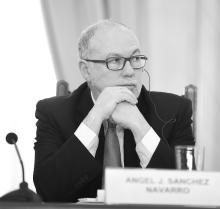
The D'Hondt Method and the scapegoat theory
A well-known economist, prominent in the media, often points out that "a man's best friend is not his dog but a scapegoat." A statement that, most assuredly, is perfectly applicable to the oft-cited, but little known, D'Hondt Method. To explain this statement, one must start by remembering that the D'Hondt Method is not a "law" in a legal sense (a rule that permits, prohibits or compels one to do or refrain from doing something), but rather a mathematical formula, whose name derives from its creator, the Belgian jurist, politician and mathematician, Victor D’Hondt. D'Hondt formulated it over 140 years ago, in 1878.
The formula has been adopted in many countries, Spain among them, to implement the mathematical principle of proportionality when resolving the practical problem of allocating parliamentary seats. The starting point is the politically fundamental element of a democratic system: the counting of the votes cast by the citizens. And the D'Hondt formula is the technical rule selected by the legislator to implement the democratic principle, converting votes (the expression of the people's democratic will, unique and sovereign under the Spanish Constitution) in parliamentary seats.
Technically, the D'Hondt formula is merely a formula whereby the seats at play are allocated to the various candidates in proportion to the votes they each obtain. It is, therefore, a proportional formula, one of the many that exist, which have a common aim: to facilitate access to Parliament to the diverse political forces that obtain a certain social backing, even if this may produce fragmented Houses and possibly make it difficult to assemble majorities. One may thus distinguish between majority-based approaches, which allocate the seats in play to the candidates that obtain a larger number of votes. In this way, and unlike the former, it facilitates the forming of majorities, although this means excluding minority forces from the Parliament.
If Victor D'Hondt was seeking to ensure a fair distribution of the seats among Belgian Catholics and liberals, belonging to different linguistic communities, Spanish law aims to ensure access of almost all significant political formations to the Congress of Deputies, and to a large extent it has succeeded in this aim.
Among the many proportional formulae, D'Hondt's is a variant based on the allocation of seats according to "the largest mean average" (and not the largest deduction), which tends to favour candidates with the largest number of votes. However, having said that, it is worth reducing the criticisms of this "law" that are frequently made of the defects of our electoral system to their fair extent. Indeed, the evident mismatch between the popular votes cast in elections and the share of seats in the Congress has often been attributed to it, when it is a well-known fact that most of this deviation is due to the size of the constituencies in which the aforementioned method is applied. Equally, this method is often blamed as the main case of the two-party system; but this was due essentially to the behaviour of the electorate, as confirmed by the overcoming thereof when citizens’ preferences have altered with no change whatsoever in the electoral formula. With the same logic, it has been blamed for the prominent role played by nationalist parties: it is claimed that this "law" is what makes such parties skew the balance defining parliamentary majorities, ignoring once again that this position is due to the popular votes and not the mathematical formula. A mere reading of the electoral data confirms, to paraphrase the law of conservation of energy, that the D'Hondt method transforms nationalist votes into nationalist seats, but it neither creates nor destroys non-nationalists.
The baselessness of such criticisms, which attribute this method with capabilities it does not have, is manifest because it has spread peacefully to all of the other elections held in Spain according to proportional principles: to the European Parliament, in the autonomous communities and the immense majority of municipal elections. In all of them, the D'Hondt method is the one selected to allocate the seats in play, operating with no major problems despite sporadic debates, which are inevitable in any kind of electoral contest.
In short, apart from its intrinsic and proven usefulness as a method of distributing seats among political forces that run in an election, the D'Hondt Method has served politically as a scapegoat on which to blame any electoral outcome. And this at a minimal cost without having to justify it: the best excuse to explain unfavourable results without an in-depth analysis of how the system really works and its actors.
You can read the full article via the following link.










Add comment